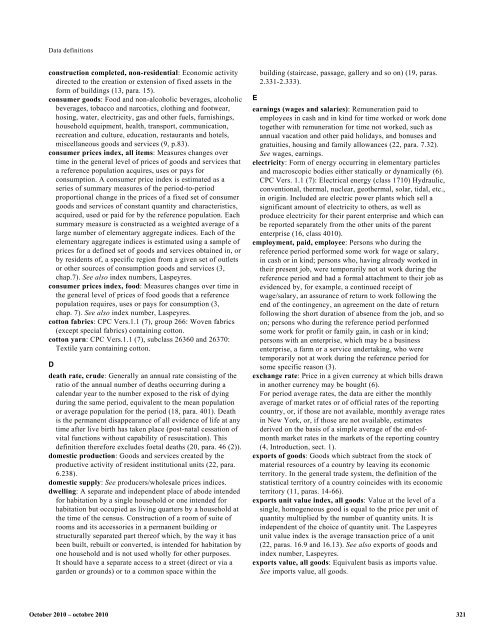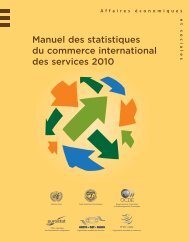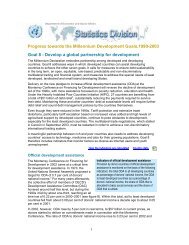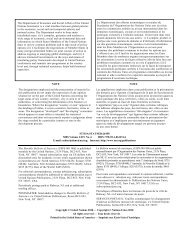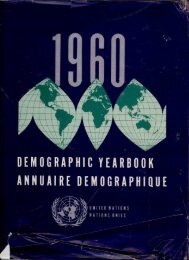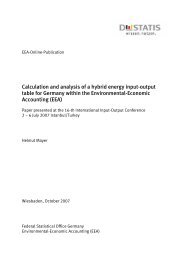dime NOTE The designations employed and the presentation of ...
dime NOTE The designations employed and the presentation of ...
dime NOTE The designations employed and the presentation of ...
- No tags were found...
You also want an ePaper? Increase the reach of your titles
YUMPU automatically turns print PDFs into web optimized ePapers that Google loves.
Data definitionsconstruction completed, non-residential: Economic activitydirected to <strong>the</strong> creation or extension <strong>of</strong> fixed assets in <strong>the</strong>form <strong>of</strong> buildings (13, para. 15).consumer goods: Food <strong>and</strong> non-alcoholic beverages, alcoholicbeverages, tobacco <strong>and</strong> narcotics, clothing <strong>and</strong> footwear,hosing, water, electricity, gas <strong>and</strong> o<strong>the</strong>r fuels, furnishings,household equipment, health, transport, communication,recreation <strong>and</strong> culture, education, restaurants <strong>and</strong> hotels,miscellaneous goods <strong>and</strong> services (9, p.83).consumer prices index, all items: Measures changes overtime in <strong>the</strong> general level <strong>of</strong> prices <strong>of</strong> goods <strong>and</strong> services thata reference population acquires, uses or pays forconsumption. A consumer price index is estimated as aseries <strong>of</strong> summary measures <strong>of</strong> <strong>the</strong> period-to-periodproportional change in <strong>the</strong> prices <strong>of</strong> a fixed set <strong>of</strong> consumergoods <strong>and</strong> services <strong>of</strong> constant quantity <strong>and</strong> characteristics,acquired, used or paid for by <strong>the</strong> reference population. Eachsummary measure is constructed as a weighted average <strong>of</strong> alarge number <strong>of</strong> elementary aggregate indices. Each <strong>of</strong> <strong>the</strong>elementary aggregate indices is estimated using a sample <strong>of</strong>prices for a defined set <strong>of</strong> goods <strong>and</strong> services obtained in, orby residents <strong>of</strong>, a specific region from a given set <strong>of</strong> outletsor o<strong>the</strong>r sources <strong>of</strong> consumption goods <strong>and</strong> services (3,chap.7). See also index numbers, Laspeyres.consumer prices index, food: Measures changes over time in<strong>the</strong> general level <strong>of</strong> prices <strong>of</strong> food goods that a referencepopulation requires, uses or pays for consumption (3,chap. 7). See also index number, Laspeyres.cotton fabrics: CPC Vers.1.1 (7), group 266: Woven fabrics(except special fabrics) containing cotton.cotton yarn: CPC Vers.1.1 (7), subclass 26360 <strong>and</strong> 26370:Textile yarn containing cotton.Ddeath rate, crude: Generally an annual rate consisting <strong>of</strong> <strong>the</strong>ratio <strong>of</strong> <strong>the</strong> annual number <strong>of</strong> deaths occurring during acalendar year to <strong>the</strong> number exposed to <strong>the</strong> risk <strong>of</strong> dyingduring <strong>the</strong> same period, equivalent to <strong>the</strong> mean populationor average population for <strong>the</strong> period (18, para. 401). Deathis <strong>the</strong> permanent disappearance <strong>of</strong> all evidence <strong>of</strong> life at anytime after live birth has taken place (post-natal cessation <strong>of</strong>vital functions without capability <strong>of</strong> resuscitation). Thisdefinition <strong>the</strong>refore excludes foetal deaths (20, para. 46 (2)).domestic production: Goods <strong>and</strong> services created by <strong>the</strong>productive activity <strong>of</strong> resident institutional units (22, para.6.238).domestic supply: See producers/wholesale prices indices.dwelling: A separate <strong>and</strong> independent place <strong>of</strong> abode intendedfor habitation by a single household or one intended forhabitation but occupied as living quarters by a household at<strong>the</strong> time <strong>of</strong> <strong>the</strong> census. Construction <strong>of</strong> a room <strong>of</strong> suite <strong>of</strong>rooms <strong>and</strong> its accessories in a permanent building orstructurally separated part <strong>the</strong>re<strong>of</strong> which, by <strong>the</strong> way it hasbeen built, rebuilt or converted, is intended for habitation byone household <strong>and</strong> is not used wholly for o<strong>the</strong>r purposes.It should have a separate access to a street (direct or via agarden or grounds) or to a common space within <strong>the</strong>building (staircase, passage, gallery <strong>and</strong> so on) (19, paras.2.331-2.333).Eearnings (wages <strong>and</strong> salaries): Remuneration paid toemployees in cash <strong>and</strong> in kind for time worked or work donetoge<strong>the</strong>r with remuneration for time not worked, such asannual vacation <strong>and</strong> o<strong>the</strong>r paid holidays, <strong>and</strong> bonuses <strong>and</strong>gratuities, housing <strong>and</strong> family allowances (22, para. 7.32).See wages, earnings.electricity: Form <strong>of</strong> energy occurring in elementary particles<strong>and</strong> macroscopic bodies ei<strong>the</strong>r statically or dynamically (6).CPC Vers. 1.1 (7): Electrical energy (class 1710) Hydraulic,conventional, <strong>the</strong>rmal, nuclear, geo<strong>the</strong>rmal, solar, tidal, etc.,in origin. Included are electric power plants which sell asignificant amount <strong>of</strong> electricity to o<strong>the</strong>rs, as well asproduce electricity for <strong>the</strong>ir parent enterprise <strong>and</strong> which canbe reported separately from <strong>the</strong> o<strong>the</strong>r units <strong>of</strong> <strong>the</strong> parententerprise (16, class 4010).employment, paid, employee: Persons who during <strong>the</strong>reference period performed some work for wage or salary,in cash or in kind; persons who, having already worked in<strong>the</strong>ir present job, were temporarily not at work during <strong>the</strong>reference period <strong>and</strong> had a formal attachment to <strong>the</strong>ir job asevidenced by, for example, a continued receipt <strong>of</strong>wage/salary, an assurance <strong>of</strong> return to work following <strong>the</strong>end <strong>of</strong> <strong>the</strong> contingency, an agreement on <strong>the</strong> date <strong>of</strong> returnfollowing <strong>the</strong> short duration <strong>of</strong> absence from <strong>the</strong> job, <strong>and</strong> soon; persons who during <strong>the</strong> reference period performedsome work for pr<strong>of</strong>it or family gain, in cash or in kind;persons with an enterprise, which may be a businessenterprise, a farm or a service undertaking, who weretemporarily not at work during <strong>the</strong> reference period forsome specific reason (3).exchange rate: Price in a given currency at which bills drawnin ano<strong>the</strong>r currency may be bought (6).For period average rates, <strong>the</strong> data are ei<strong>the</strong>r <strong>the</strong> monthlyaverage <strong>of</strong> market rates or <strong>of</strong> <strong>of</strong>ficial rates <strong>of</strong> <strong>the</strong> reportingcountry, or, if those are not available, monthly average ratesin New York, or, if those are not available, estimatesderived on <strong>the</strong> basis <strong>of</strong> a simple average <strong>of</strong> <strong>the</strong> end-<strong>of</strong>monthmarket rates in <strong>the</strong> markets <strong>of</strong> <strong>the</strong> reporting country(4, Introduction, sect. 1).exports <strong>of</strong> goods: Goods which subtract from <strong>the</strong> stock <strong>of</strong>material resources <strong>of</strong> a country by leaving its economicterritory. In <strong>the</strong> general trade system, <strong>the</strong> definition <strong>of</strong> <strong>the</strong>statistical territory <strong>of</strong> a country coincides with its economicterritory (11, paras. 14-66).exports unit value index, all goods: Value at <strong>the</strong> level <strong>of</strong> asingle, homogeneous good is equal to <strong>the</strong> price per unit <strong>of</strong>quantity multiplied by <strong>the</strong> number <strong>of</strong> quantity units. It isindependent <strong>of</strong> <strong>the</strong> choice <strong>of</strong> quantity unit. <strong>The</strong> Laspeyresunit value index is <strong>the</strong> average transaction price <strong>of</strong> a unit(22, paras. 16.9 <strong>and</strong> 16.13). See also exports <strong>of</strong> goods <strong>and</strong>index number, Laspeyres.exports value, all goods: Equivalent basis as imports value.See imports value, all goods.October 2010 – octobre 2010 321


